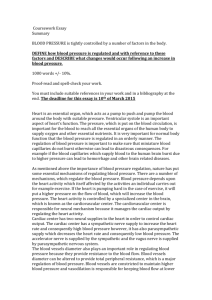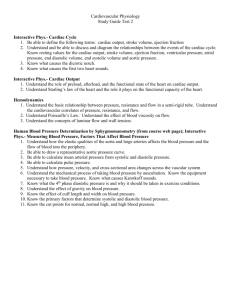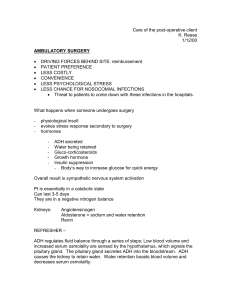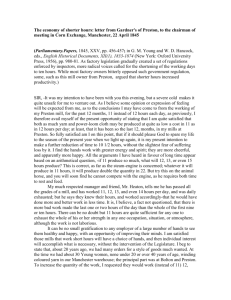blood pressure regulation
advertisement
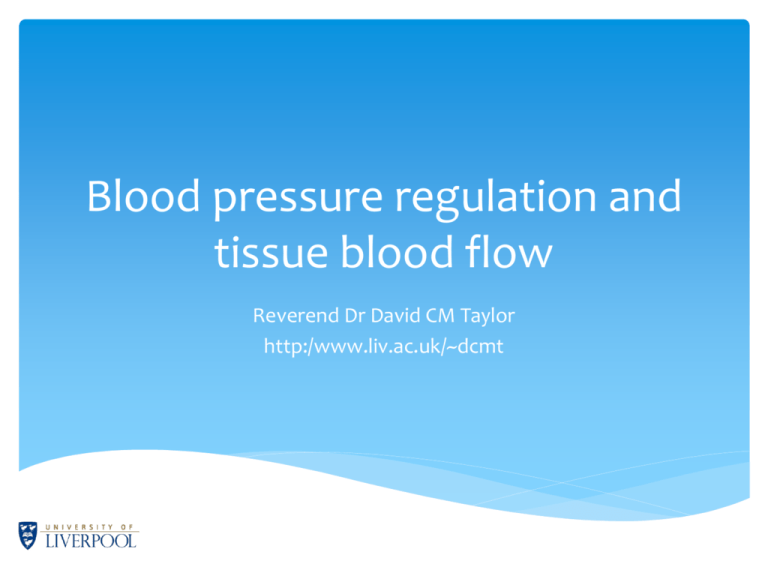
Blood pressure regulation and tissue blood flow Reverend Dr David CM Taylor http:/www.liv.ac.uk/~dcmt Learning outcomes Define the term blood pressure – systolic, diastolic, mean arterial pressure Regulation of blood pressure (receptors and hormones) Fluids and fluid volumes Renin angiotensin system – what triggers renin Concept of negative feedback loop Blood Pressure Depends upon the amount of blood leaving the heart cardiac output and the resistance of the vasculature total peripheral resistance Peripheral Resistance Which will give the greater flow ? Peripheral resistance 2 Which will give the greater flow ? Cardiac Output Heart rate x stroke volume End diastolic volume - End systolic volume Stroke volume Cardiac output Heart rate Putting this together Stroke volume Cardiac output Heart rate Cardiac output x Total peripheral resistance Blood pressure Chapter 18, p 207 in Preston and Wilson (2013) Chapter 11, p 525 in Naish and Court (2014) Pressures Systolic pressure is the result of contraction (systole) Diastolic pressure is when the heart is relaxed (diastole) Pulse pressure is the difference between them Mean arterial pressure is estimated as Diastolic pressure + 1/3(pulse pressure) This is because the pulse is not a sine wave Strictly speaking we should include central venous pressure (but it is usually small enough to be ignored) Chapter 19, p 219 in Preston and Wilson (2013) Chapter 11, p 554 in Naish and Court (2014) Fluids In a male 60% of body weight is due to fluid, in a female 55% 2/3 of the fluid is inside cells – intracellular fluid (ICF) 1/3 is extracellular (ECF) Of the ECF 80% is interstitial fluid And 20% is plasma Osmotic pressure and hydrostatic pressure determine the flow between interstitial fluid and plasma Chapter 3, p 30 in Preston and Wilson (2013) Chapter 2, p 20 in Naish and Court (2014) Postulated mechanism for hypertension Increased sympathetic activity Leads to increased cardiac output And peripheral vasoconstriction (to protect the capillary beds) Drop in blood flow Triggers renin-angiotensin system Evidence Cross transplantation studies show that essential hypertension has its origins in the kidneys. Human and animal studies So does renal denervation Little evidence that “stress” is involved in essential hypertension But, of course, drugs that decrease sympathetic activity lower blood pressure. Beevers, G., Lip, G. Y. H., & O’Brien, E. (2001). The pathophysiology of hypertension. BMJ : British Medical Journal, 322 (7291), 912–916. Control Autonomic N.S. Volume ADH Pressure Chemicals Local Blood Flow Angiotensin Pressure Sensed by baroreceptors in carotid arteries and aortic arch an increase in pressure causes a decrease in sympathetic activity a decrease in pressure causes an increase in sympathetic activity Chapter 20, p 236 in Preston and Wilson (2013) Chapter 11, p 554 in Naish and Court (2014) Volume Sensed by atrial volume receptors A decrease in volume causes an increase in ADH secretion and a decrease in ANF secretion Chapter 20, p 244 in Preston and Wilson (2013) Chapter 11, p 556 in Naish and Court (2014) Chemicals A decrease in O2, or more usually an increase in CO2 or H2 causes an increase in chemoreceptor activity which increases sympathetic activity Chapter 20, p 238 in Preston and Wilson (2013) Chapter 11, p 555 in Naish and Court (2014) Local Blood Flow (kidney) Decreased renal blood flow Monitored by JGA cells Renin production Angiotensinogen Angiotensin I Converting enzyme Angiotensin II Sodium reabsorption Aldosterone Potassium secretion Vasoconstriction Chapter 20, p 243 in Preston and Wilson (2013) Chapter 11, p 556 in Naish and Court (2014) Hormones Angiotensin II is a vasoconstrictor Aldosterone increases vascular sensitivity to Angiotensin II ADH (anti-diuretic hormone) increases water reabsorption ANF decreases sodium reabsorption Chapter 20, p 244 in Preston and Wilson (2013) Chapter 11, p 556 in Naish and Court (2014) Overview ADH Fluid loss Arterial pressure Blood volume Venous return heart rate vol sympathetic contractility vasoconstriction Cardiac output baro Arterial pressure chemo CNS Cardiac output Venous return veins capillary pressure Blood volume Local blood flow kidney renin/angiotensin aldosterone
